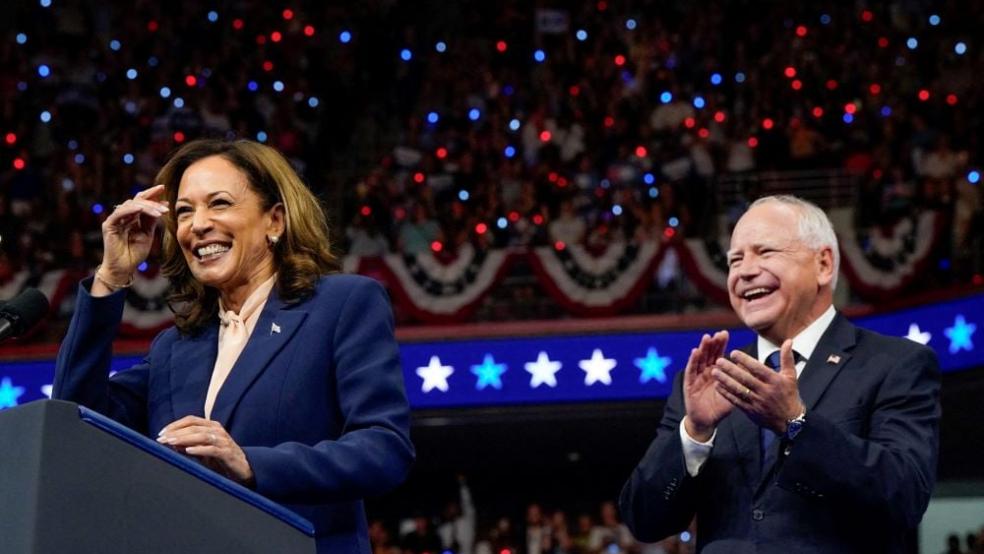If we had told you a month ago that the governor of Minnesota would be on the Democratic presidential ticket in November, you probably would have thought we were loony — and you almost certainly would have struggled to name him. Yet on Tuesday, Vice President Kamala Harris, the presumptive Democratic presidential nominee, chose that relatively little-known Minnesota governor, Tim Walz, to be her No. 2.
It’s another sign of how quickly this presidential contest has changed over the last 16 days, since President Joe Biden abandoned his bid for a second term.
Over the past two weeks, Walz emerged as a dark horse vice-presidential contender alongside other potential choices who were thought to offer more obvious electoral benefits, including Gov. Josh Shapiro of Pennsylvania and Sen. Mark Kelly of Arizona, both popular officials from key swing states.
Who is Tim Walz? The 60-year-old Walz is now in his second term as Minnesota governor. He also is chair of the Democratic Governors Association. But he didn’t enter politics until he was in his 40s.
“He grew up in a small town in Nebraska, spending summers working on his family’s farm,” Harris wrote in an Instagram post. “His father died of cancer when he was 19, and his family relied on Social Security survivor benefit checks to make ends meet.”
Walz went on to serve for 24 years in the Army National Guard and worked as a high school teacher and football coach. He retired from the Guard in 2005 as a command sergeant major, one of the top enlisted ranks.
After winning a long-shot bid for Congress in 2006, Walz served six terms in the House from 2007 to 2019, repeatedly winning elections in a Republican-leaning, rural district. He was ranked the 7th most bipartisan House member during the 114th Congress and the 88th most bipartisan in the 115th Congress according to The Lugar Center and the Georgetown University McCourt School of Public Policy.
As governor, his record is decidedly more liberal. He is known for providing free school breakfast and lunch, implementing tuition-free college for low-income residents, defending abortion rights and legalizing recreational marijuana for adults. He received some criticism for his handling of the Covid-19 pandemic and the protests sparked by the murder of George Floyd in Minneapolis.
What Walz brings to the Democratic ticket: Walz is expected to bring a broad, folksy appeal to the ticket that Harris clearly hopes will win over working-class voters in the “Blue Wall” states of Wisconsin, Michigan and Pennsylvania. Harris’s choice of Walz “could be a play to widen her party’s polished coastal image — or an attempt to placate her party’s left wing,” The Washington Post’s editorial board suggests. “Most likely, it was both.”
Described as a happy warrior, Walz has already won praise among Democrats this election cycle for his political messaging portraying former President Donald Trump and Sen. JD Vance as “weird.” And his selection was met with positive statements from a broad range of Democrats.
“As a governor, a coach, a teacher, and a veteran, he’s delivered for working families like his own,” Harris said in a statement. “We are going to build a great partnership. We start out as underdogs but I believe together, we can win this election.”
The Trump campaign immediately sought to paint Walz as a “radical leftist” who had enacted a liberal in his state. “It’s no surprise that San Francisco Liberal Kamala Harris wants West Coast wannabe Tim Walz as her running-mate – Walz has spent his governorship trying to reshape Minnesota in the image of the Golden State,” Trump Campaign Press Secretary Karoline Leavitt said in a statement.
Walz has embraced the liberal label. Asked by CNN recently if his record would provide fodder for Trump’s attacks calling him “a big government liberal,” he responded with a dose of sarcasm.
“What a monster. Kids are eating and having full bellies, so they can go learn, and women are making their own health care decisions. And we're a top five business state, and we also rank in the top three of happiness,” he said, adding, “Oh, and, by the way, you're going to have personal incomes that are higher, and you're going to have health insurance. So, if that's where they want to label me, I'm more than happy to take the label.”
The Washington Post’s editorial board warns that Walz’s fiscal record might warrant caution when translated to the national level: “Mr. Walz increased the state budget by 40 percent and spent most of a $17.5 billion state surplus. He signed off on a new child tax credit, free school breakfast and lunch for K-12 students and billions of dollars on affordable housing and infrastructure. He signed a law to mandate utilities go carbon-free by 2040.”
But Walz reportedly has pushed back on some arguments about fiscal responsibility. “The idea that you’re somehow more fiscally responsible by NOT investing in education, healthcare, and transportation makes a nice political talking point—but it makes no sense,” he said in 2018, according to The Washington Post’s Jeff Stein. “Not when we could have a better educated, healthier workforce that lives longer and contributes more to the economy.”
What’s next: After a joint rally in Philadelphia this evening, Harris and Walz are scheduled to appear in four other battleground states over the coming days, making campaign stops in Wisconsin, Michigan, Arizona and Nevada. Two planned events in North Carolina and Georgia have been postponed due to Tropical Storm Debby.
The bottom line: Walz was, in many ways, a safe pick. He’s considered the most liberal of Harris’s VP contenders, but the selection of a relatable, populist progressive may calm the left wing of the party and add some Midwestern appeal while potentially allowing Harris to run to the center.




